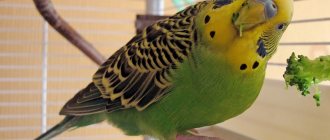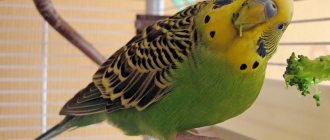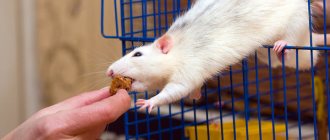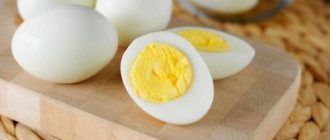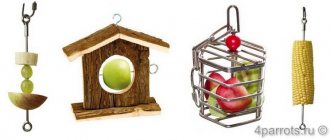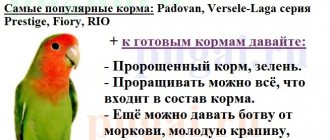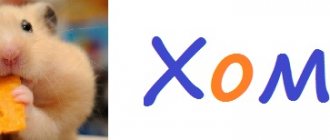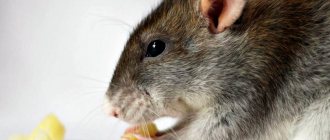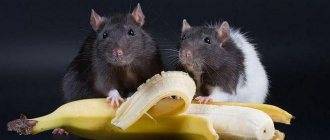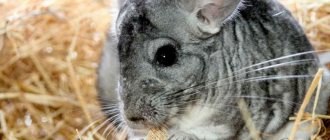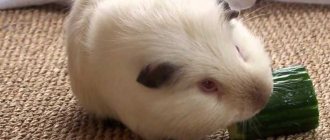A parrot's overall health and life expectancy depend on its nutrition. Therefore, the issue of feeding should be approached responsibly. From a very early age you need to choose the right diet. Feeding your pet food from the common table is prohibited! This can not only harm the parrot, but also be fatal.
Below in the article we will look at what food is most suitable for a parrot. The main diet includes: grain mixtures, cereals, fruit and vegetable components, greens and other options.
Grain food for parrots
The parrot must eat grain every day. This is his main food. Feeding once a day or adding little bits throughout the day doesn’t matter. The main thing is that it is a sufficient amount. A parrot should not be without grain food for more than a day.
In the veterinary pharmacy and pet store Gomeovet, there is a large selection of grain mixtures for different types of parrots. Their composition varies depending on the size of the parrot and its species, from budgies to large breeds. When buying food, pay attention to the integrity of the packaging and expiration date. Before you pour food into your parrot's feeder, check that there is no debris or other unnecessary impurities.
To prevent your pet from getting bored with grain, you can germinate it, thereby diversifying its diet. Sprouted grain has a large amount of vitamins and has a beneficial effect on the body. In order not to provoke the parrot's sexual behavior, you should wait until the grain has sprouted completely into grass.
In addition to sprouted grains, you can give nettle, dandelion, lettuce, green oat and wheat grass, and regular salad. These herbs can be easily grown on a windowsill.
The feeding of large breeds of parrots already includes additives in the form of seeds and nuts. You should not add these treats separately so as not to overfeed your pet. Rarely, you can use them for encouragement or treats.
Why give a parrot nuts?
Lipids occupy an important place in the diet of parrots. The need for them increases in winter, when the bird needs additional energy to warm its body. A good source of bioenergy for parrots are the fats that are included in the product. They contain a number of useful microelements and vitamins that improve the health of birds.
The calorie content of lipids is higher than that of proteins or carbohydrates. They are the main source of energy and are involved in the production of a number of hormones, vitamins and enzymes. Thanks to these natural organic compounds, polyunsaturated fatty acids enter the stomach. A deficiency of them in the parrots’ menu causes metabolic disorders, and an excess provokes the appearance of excess weight. Kernels should be fed in moderation.
A PARROT EATS A WALNUT. FOOD OF LARGE PARROTS
Vegetables, fruits and berries
Having a pet, such as a cockatiel, the conditions for keeping and feeding it are not particularly different from other types of parrots, the main thing is to do everything according to the rules. Your pet should be accustomed to a routine from an early age.
The menu must include fruits and vegetables. It happens that birds are reluctant to eat these delicacies; the owner’s task is to competently approach the solution to this problem. You can cut them beautifully or select pieces of the appropriate size.
Healthy fruits:
- apricot;
- a pineapple;
- plum;
- pear;
- apple;
- cherry;
- watermelon;
- cranberry;
- kiwi;
- peach and others.
Before serving, it is better to peel the fruit and remove the seeds, if any. You can make preparations for the winter, and in winter defrost and treat the parrot.
Healthy vegetables:
- pumpkin;
- carrot;
- zucchini;
- cucumber;
- pepper;
- tomato;
- broccoli;
- green pea.
Most vegetables should be given fresh to retain all their beneficial properties; some can be pre-boiled.
You cannot give:
- mango;
- potato;
- persimmon;
- fruits in sugar;
- papaya.
What fruits and nuts are most suitable for parrots?
Legend: A - Amazons AR - aratings ARA - macaws B - noble parrots C - budgerigars F - grays L - lorises and lorikeets K - cockatoos N - lovebirds R - cockatiels, rosellas and others like them Apricots: A, AR, APA, B, C, F, L, K, R. Rich in provitamin A, and some varieties are also rich in vitamin C and B vitamins. The seeds must be removed due to the content of hydrocyanic acid in them. The fruit halves are skewered or crushed and served in a fruit salad. American or Brazil nut (Bertholletia excelsa): AP, APA, F, K. It contains up to 70% fat, few carbohydrates and a lot of minerals (phosphorus, potassium, calcium and iron) and vitamin B1. It is better to feed it whole - for large parrots this is a good toy and treat. Pineapple : A, AP, B, B, G, K, R. Contains biotin, vitamins B12, C and E, as well as 16 minerals, including potassium, magnesium, calcium and phosphorus, primarily. Cut into rings. Peeled and cored. It is cut into pieces and given to the birds. Oranges : A, AP, APA, B, B, G, L, K, N, R. They contain a significant amount of vitamin C and provitamin A, as well as B vitamins, primarily biotin and folic acid. They also contain a high content of minerals, primarily potassium, calcium and phosphorus. They have a regenerating effect. Be sure to peel. Finely chop and mix with other fruits in a fruit salad. Large parrots take the whole slices. As a rule, birds suck the juice from the orange. Grays and parakeets are especially fond of oranges. Lori is given freshly squeezed juice. Peanuts : AP, APA, F, N, R. Contains 48 percent oil, mainly oleic and linoleic acids. As well as protein and carbohydrates. Minerals include potassium, calcium, magnesium and iron. And then B vitamins, as well as provitamin A and vitamin D. Due to the high fat content, they are given as a treat. It is necessary to give only fresh and high-quality nuts, since birds are often poisoned by low-quality peanuts. Watermelon : A, AP, ARA, B, F, L, K, N, R. 95% consists of water. Contains a valuable amount of provitamin A and B vitamins. It is good to cut it into halves and place it on metal pins. In vegetable salad it is not conditioned. Bananas : A, AP, APA, B, B, G, L, K, N, R. “Fruits of Paradise,” as they are called, are rich in potassium, provitamin A and vitamins C and B6. They also contain carbohydrates, which leads to quick saturation. Peel, cut into circles and place them on branches. Very good for feeding lorises. Black elderberry (Sambucus nigra): A, AP, APA, B, C, G, J, N, R. Dry berries are especially appreciated by Australian flat-tailed parrots. They are added to various mixtures. Fresh berries have their fans. For example, gray. Other varieties, such as grass elder (Sambucus ebulus) or red elder (Sambucus racemosa), are less readily eaten and may even pose a danger. Grapes : A, AR, ARA, B, V, G, L, K, N, R. Rich in ballast substances. Contains all B vitamins except B12. As well as vitamin C, potassium, calcium, phosphorus, iron and fructose. Before giving it, you should wash it well with hot water. Light yellow sweet varieties are eaten more readily. The ones with bones are better. It is recommended to give it by cutting it into halves. Amazons, aratingas, slender-billed and red-tailed parrots are especially fond of grapes. Many parrots also eat raisins well. Cherry : A, AP, APA, B, B, G, K, L, R. Rich in ballast substances, contains a lot of potassium, iron, vitamin C and almost all B vitamins. Sweet varieties have more dicarboxylic acid than sour ones. A treat for all birds that prefer darker, sweeter varieties. Before giving, you need to wash the fruits well and remove – at least in sour varieties – the pits, which are rich in hydrocyanic acid. Make sure that birds do not come across moldy fruit. Loris and rosellas are especially fond of cherries. Pomegranate : A, AP, APA, B, B, G, L, K, N. It contains a lot of potassium, vitamin C, pantothenic, nicotinic acids, vitamins B1 and B2. Also rich in phosphorus. Pomegranate owes its specific taste to tannic acid. The grains are given in fruit salad. Or they offer the birds whole halves, from which they pick out the grains themselves. The sap is good for lorises and lorikeets. We especially love Amazons, Macaws and Cockatoos. Grapefruit : B, F, R. Along with sugar, organic acids, minerals and B vitamins, it is rich primarily in vitamin C. White is eaten more readily than regular fruit. Used as a component of fruit salads. Walnut : AP, APA, F, N, R. Along with copper and magnesium, it contains a lot of potassium, folic acid, vitamins B1, B2 and B6, as well as phosphorus, iron, nicotinic and pantothenic acids. Contains a lot of ballast substances. Due to its high fat content (60%), it is given only as a treat. Large parrots can be given whole, medium and small parrots can be given in halves - this will be a good toy. Make sure that the nuts are not contaminated with mushrooms. Pears : A, AP, APA, B, B, F, L, K, N, R. Compared to apples, they contain slightly more carbohydrates, protein and fiber, as well as little fat and fruit acids, which is why pears have a sweet taste. They contain a lot of potassium, vitamin B2 and folic acid. The halves are placed on the branches. Can be finely chopped and added to fruit salad. Very soft pulp is good to give to loris. Be sure to wash fruits before serving. Guava : ARA, B, K. One of the richest fruits in vitamin C. Contains citric, nicotinic and malic acids, pectins, provitamin A, potassium, phosphorus and iron. Ripe fruits are loved by lorises and noble parrots. Semi-mature - macaws and cockatoos. They especially like the seeds. Honey melon (Cucumis melo): A, AP, APA, B, F, L, K, N, R. It is worth cutting it into halves and placing it on metal pins. Almost all parrots love melon. Consists of 90% water. Contains valuable amounts of provitamin A and vitamin C, potassium, calcium and phosphorus. Blackberries : A, AP, APA, B, B, G, K, R. In addition to potassium, magnesium and copper, they contain a significant amount of provitamin A and vitamin C. Give only perfect berries: smooth, shiny, hard. Entirely. Figs : A, AP, APA, B, F, K, L, N. Contains a lot of calcium and iron, as well as B vitamins. Almost two-thirds of dry fruits consist of carbohydrates. Figs activate metabolism. It is best to give it fresh in halves on the day of purchase. Dry ones are soaked and crushed into pieces. Carambola : A, AP, APA, F, K. Contains a lot of vitamin C, as well as some amount of provitamin A, niacin, potassium, phosphorus and iron. Rich in acids: oxalic, tartaric, malic. The star-cut fruit attracts the attention of birds with its unusual shape. So there are usually no problems with feeding. It is especially loved by lorises, aratingas and medium-sized parrots. Light fruits are preferable. Cashew : AP, APA, F, N, R. Along with calcium, phosphorus, potassium, it contains provitamin A and vitamins B1, B2 and E. It should not be given with the shell, which contains a lot of toxic substances, or in salted form. Kiwano (Cucumis metuliferus): AP, APA, R. 90% consists of water. The fruit is rich in vitamin C and contains iron and potassium. It is low in carbohydrates and protein. Since kiwano tastes like melon and cucumber, and has a slight banana aroma, it attracts many parrots. Kiwano has slippery seeds, so it is better to cut it in half and plant it on branches. Particularly popular with jumping, South American slender-billed and white-bellied parrots. Kiwi : A, AP, APA, B, B, G, K, L, N, R. Contains an extremely high amount of vitamin C, almost twice as much as citrus fruits. And besides this, potassium, calcium, phosphorus, magnesium and iron. Hard fruits are suitable for feeding; soft ones are difficult to process. Kiwi is peeled, cut into small pieces and used in fruit salad. It is added there last, as its juice softens the rest of the fruit. Kiwi fans include Amazons and the yellow-fronted jumping parrot. You can also cut the kiwi into two halves and string it onto branches. Strawberry : A, AP, APA, B, B, F, L, K, N, R. Along with provitamin A and vitamin B1, it primarily contains vitamin C, and of minerals, in addition to zinc, phosphorus, manganese and copper, a large amount iron, potassium, magnesium and calcium. Serve whole or in fruit salad. Red color attracts birds. Coconut : A, AP, APA, B, F, K. Fresh coconuts are rich in ballast substances and potassium, as well as copper, iron, zinc, selenium, folic acid, phosphorus, vitamins E and group B. Coconuts contain about 36, 5% fat. Because of this, they are given as a treat to large parrots, primarily various species of macaws and palm cockatoos. After the milk is drained through the hole made using a hammer and needle, the coconut can be placed in an oven at 180 degrees Celsius for 15-30 minutes. The nut is cracking. Pieces of it are given to parrots; they can be placed on stainless metal pins. Gooseberry : A, AP, APA, B, G, K, L, R. Rich in vitamins C, E, group B, provitamin A, calcium, potassium, phosphorus, sodium, silicon. It has a sour taste due to malic and citric acids. Due to its sour taste, it is hardly a main forage fruit. But sometimes you can give. It is especially readily eaten by black-headed white-bellied parrots and birds that do not really like sweet fruits - gray parrots or parakeets. Kumkuat : A, AP, APA, F, L. The fruit is rich in pectin and minerals (primarily potassium, calcium and phosphorus), as well as vitamins B1, B2 and C. It is a source of copper. More suitable for medium and large parrots, which often suck the juice out of it and then throw it away. Before giving it to the birds, cumquat must be thoroughly washed. Hazel : AP, APA, F, R. They contain a lot of magnesium, potassium and copper, as well as vitamins B1, B6 and E, folic and pantothenic acid. There is also phosphorus, iron, zinc and calcium. Fat content exceeds 60 percent. Contains a lot of fat. It is easily infected by fungi, so you need to carefully monitor the quality of the fruit. Grays take particular pleasure in chewing the shell. Lychee (Litchi chinensis), longan (Dimocarpus longan) and rambutan (Nephelium lappaceum): A, AP, APA, F, K. Longan has slightly more minerals than its relatives. Rambutan contains a certain amount of iron. All three fruits are sources of vitamin C. Longan and rambutan are loved by red-tailed parrots, white-bellied parrots and parakeets. Lychees are loved by Amazons, Grays and Australian parakeets. All three fruits must be peeled, pitted, and the pulp offered to the parrots. Mango : A, AP, APA, B, B, G, L, K, N, R. Mango has many vitamins, among others - A, B3, B5, B6, C and E. There is copper, manganese, magnesium and zinc . The sweet fruit is very rich in potassium, and therefore has a dehydrating and disinfecting effect. The stone is cut out, and the fruit is either placed in halves on branches, or finely chopped, added to a fruit salad. Large parrots such as macaws and palm cockatoos can be given whole, along with a bone, which will serve as entertainment. Tangerines : A, AP, APA, B, B, G, K, L, N, R. Rich in vitamin C, potassium, calcium, fluorine, magnesium, phosphorus, as well as provitamin A and B complex vitamins. Fruit glucose content is high. They give it the same way as oranges. Raspberries : A, AP, APA, B, B, G, K, N, R. Along with vitamins C, group B, provitamin A, it contains, first of all, potassium, phosphorus, iron, calcium and magnesium. It is also rich in citric acid and pectin. Since raspberries absorb water well and then quickly lose their flavor, it is better not to wash them if possible. Therefore, it is better to give freshly picked berries from your garden. Parrots are reluctant to eat frozen raspberries. They prefer dark varieties. Passion fruit : A, AP, APA, B, G, L. Along with a large amount of vitamin C, it also contains a lot of nicotinic acid, provitamin A, potassium, iron, magnesium and phosphorus. The juice of the fruit has a calming effect, and the grains are used as a remedy against worms. Both color variations of passion fruit (yellow and purple) taste the same. But parrots choose purple fruits because they exude the aroma of apricots. Tame parrots are given halves. Grays, who usually have difficulty getting used to the fruit, are especially fond of passion fruit. Almonds : AP, APA, F, N, R. Along with 54% fat, they contain a lot of protein and carbohydrates, as well as important minerals (potassium, phosphorus, iron, calcium, magnesium) and vitamins B1, B2, B6. They give it as a treat. Papaya : A, AP, APA, B, G, K, L. Very rich in vitamins B1, B2, B5, C and provitamin A. It is a source of papain, an enzyme that breaks down proteins. Before feeding, the inedible peel is removed, then the fruit is cut into two halves and the seeds are removed. And the halves are crushed and added to vegetable salad. Peach and nectarine : A, AP, APA, B, B, G, K, L, N, R. They primarily contain provitamin A and B vitamins, as well as calcium, phosphorus, potassium and iron. It is better to buy unripe varieties with easily separated seeds. The seeds are removed because they contain hydrocyanic acid. Peaches and nectarines are first thoroughly washed in hot and then in cold water. Parrots eat fruits with yellow flesh more readily than those with white flesh. All parrots love peaches, but most of all the slender-billed parrots. Carob fruits (Ceratonia siliqua): A, APA, B, G. Used as an integral part of grain mixtures. Rowan : A, AP, APA, B, B, G, K, N, R. Very rich in vitamin C, less provitamin A, sorbic acid, sorbitol. It also contains parasorbic acid and tannin, and therefore has a bitter, tart, sour and viscous taste. It can be given all year round in all forms. Grays especially love her. Plum : A, AP, APA, B, F, L, K, N, R. Contains almost all B vitamins, and therefore has a good effect on metabolism. It also contains carbohydrates and minerals - potassium, magnesium, calcium and phosphorus. Blue plums are more popular with gray parrots and Australian parakeets, while yellow plums are favored by South American parrots and lorises. It is better to take fruits covered with a whitish “thermal layer”, which is removed before feeding to the birds. In any case, plums should be thoroughly washed and fed to birds without seeds containing hydrocyanic acid. Currants : A, AP, APA, B, F, L, K, N, R. Along with provitamin A and B vitamins, currants contain three times more vitamin C than citrus fruits. It also contains a lot of calcium, potassium, phosphorus, sulfur, pectin and citric acid. Black is especially good for health. But birds are more willing to eat red ones than parrots. It is better to give it freshly picked from your garden. Peruvian physalis : AP, APA, B, G, K. Contains a lot of provitamin A, as well as vitamins C and group B. Of the mineral substances, phosphorus and iron should be mentioned first of all. And then organic acids (primarily citric acid). Parrots are given berries that are golden brown or orange in color. Physalis is especially valued by “seed specialists” cockatoos. Dates : A, AP, APA, B, G, K. Contain the highest amount of fruit glucose of all fruits, as well as vitamin D, iron, phosphorus and magnesium. Birds like it better in dried form. Cockatoos especially love them. Small parrots are given finely chopped. Whole large parrots. Japanese or oriental persimmon, kaki (Diospyros kaki): A, AP, APA, F, K, L. Rich in provitamin A and contains valuable amounts of vitamins C and group B, as well as potassium and copper. It should be peeled and given only when ripe. The pulp is good for lorises and lorikeets. Cherimoya (Annona cherimola): AP, APA, F. A very filling fruit, as a quarter consists of carbohydrates, especially glucose. In addition to vitamins B1 and B2, it is rich in vitamin C, as well as nicotinic acid. Of the minerals, calcium, phosphorus and iron are especially worth mentioning. Give in halves, removing all seeds that contain alkaloids. Blueberries : A, AP, APA, B, C, G, K, N, R. Berries collected in nature must be thoroughly washed. Parrots usually eat blueberries the first time they eat them. Noble two-colored parrots especially love it. Rosehip : A, AP, APA, B, B, G, K, N, R. Rich in vitamin C. Also contains provitamin A, vitamins B1, B2, E and K, minerals - a lot of sodium, calcium, manganese and copper - as well as microelements – tannins and pectin. It is especially loved by parakeets, Amazons and Grays. Birds enjoy gnawing seeds from fruits. You can even give fruits collected in winter: their consistency does not change after cold weather. Apples : A, AP, APA, B, B, G, L, K, N, R. They contain little protein, a lot of water, few carbohydrates, a small amount of fatty acids in the peel, a lot of vitamins - especially C - and microelements. They are given in all possible forms. You can cut it into pieces and give it in a feeder or in the form of a “kebab”, mix it with sprouted food, put it whole on a skewer and hang it in a cage. Birds love to pluck piece by piece from a whole apple. According to Volker Wurth (Germany).
Source: https://www.superpopugai.ru/forum/topic3588.html
Branch food for parrots
Feeding parrots must be correct. Their diet should contain not only grain mixtures, vegetables and fruits, but also twig food. Most owners don’t even know that twigs are necessary for proper nutrition. The twigs contain fiber and microelements, and they also help care for the beak.
What branches can you give:
- birch;
- hazel;
- elder;
- aspen;
- maple;
- Linden;
- Rowan;
- Apple tree.
They need to be collected away from roads and first doused with boiling water. Twigs can be given all year round. In winter, they should be placed in water to allow the buds to swell.
Supplements and vitamins
They are sold ready-made in pet stores. The main such additives include:
Chalk. It is an ideal source of calcium, the deficiency of which in birds worsens the condition of their claws and beaks. Chalk is sold in the form of special toys or in grated form. You have to use exclusively specialized purified chalk, so it is forbidden to give the wavy construction chalk, which contains numerous impurities and additives that are harmful to the bird.- Eggshell. It should be washed well, and it is recommended to give it in crushed form. It contains a lot of magnesium, sulfur, calcium and iron, so it is an ideal source of vitamins for a small bird.
- Bone flour. It is offered in grated form at every pet store and also contains calcium and phosphorus. It is often used by manufacturers of feed mixtures, so if you buy a high-quality product, then there is no need to additionally buy bone meal.
Pet stores offer customers specialized vitamins and minerals. They are often small toys that are attached to the walls of the cage. Parrots eat these supplements while playing, which has a positive effect on their health and appearance.
Water
Budgerigars should always have free access to clean water. It is poured into special drinking bowls, available on the market in various shapes and sizes. The water is changed daily, otherwise it quickly becomes polluted. But not all water is suitable for birds.
It is recommended to give the birds boiled liquid. Raw water is allowed only if it is previously well purified and therefore does not contain harmful components. It is allowed to use mineral water with gases, which is pre-filtered. This water contains potassium, magnesium and sodium. It is allowed to pour a decoction of chamomile or rosehip into the drinking bowl.
Wavys can be given a small amount of freshly squeezed juice, which is mixed with water, and lemon or apple juice without additives is usually used.
Juices and water
Parrots must get water. Its amount depends on how much water the pet gets from fruits and vegetables and what the air temperature is in the room. You need to change the water daily, even if it seems to you that your pet hasn’t drunk it. In summer, you need to change it 2 times a day.
It is better not to give boiled, carbonated and tap water. Fill the drinker with filtered or bottled water. It is possible to add lemon juice, rosehip or chamomile decoction to the water.
Juices are considered no less beneficial for parrots. You can make it in a juicer or buy ready-made baby juices, the main thing is that they do not contain sugar. It is possible to dilute them with water. Keep an eye on the freshness of the juice, they can spoil very quickly, especially in summer.
Authorized Products
Parrots are not carnivores, so their diet should consist mostly of plant products. All products available for feathered pets can be divided into the main menu and incentive treats.
Basic diet
The diet of birds should be safe, healthy and varied. The basis of a parrot's diet is grains and seeds.
The main feeding of parrots is carried out with balanced food containing:
- canary and hemp seed;
- meadow grass seeds;
- millet;
- oats;
- flax seeds;
- sunflower seeds;
- sesame.
You can make mixtures yourself or purchase ready-made food, available in a wide range.
The grain mixtures in the feed are formulated based on the needs and age of the bird. Preference should be given to premium segment feeds - the quality of the grain and the ratio of crops in them is optimal.
If, after opening the package of food, you notice an unpleasant moldy smell, or if the quality of the food is in doubt, you should throw it away and not risk your pet’s health.
Porridge
Porridge is given to parrots daily in small quantities. To save time, you can freeze the porridge in portions. Remove the porridge from the freezer in advance to have time to defrost it.
Porridge is cooked for parrots:
- buckwheat;
- oatmeal;
- rice;
- millet;
- pearl barley
It is easily absorbed during the digestion process of birds and normalizes the functioning of the system.
Vegetables
Vegetables contain a large number of useful minerals and vitamins. All vegetables must be pre-processed: thoroughly washed and chopped (grated or cut into pieces).
The list of vegetables that are good for parrots includes:
- young corn;
- beet;
- zucchini and pumpkins, pumpkin seeds;
- turnip;
- carrots – contains carotene;
- cabbage is a source of vitamins and substances;
- legumes in the milk maturity phase - contain protein and sugars;
- sweet pepper - can be given along with seeds;
- cucumbers;
- tomatoes are useful along with seeds.
It is better to give preference to vegetables from your own plot, because... the amount of nitrates and toxic chemicals in them is significantly lower. All fruits must be clean and fresh.
Fruits
Fruits, like vegetables, should be present in small quantities in your pet’s diet all year round. They are a source of sugars and vitamins for birds.
Allowed:
- apples are a favorite and safe treat;
- pears;
- pineapples (not canned);
- bananas (without peel);
- citrus fruits (oranges, tangerines);
- Stone fruits - plum, peach, sweet cherry, apricot, cherry;
- grape;
- watermelon and melon (with seeds);
- kiwi;
- pomegranate;
- berries - lingonberries, rowan, honeysuckle, gooseberries, rose hips, blueberries, raspberries, currants, strawberries and sea buckthorn.
Berries can be stored for future use in the winter by freezing or drying them. They should be defrosted or soaked before feeding.
Porridge
Porridge for parrots is also very healthy. This is not only a source of many microelements, but also a means that will help birds normalize their metabolism if it is disturbed. Cook porridge only in water, without adding sugar or salt.
You can cook complex mixtures consisting of several cereals, as well as mono-porridge for budgies from buckwheat, oatmeal, and brown rice. You can add legumes, as well as grated fruits or vegetables to the porridge. The finished cereal can be cooked viscous or crumbly. In this case, listen to the food tastes of your pet.
You can store the cooked porridge in the refrigerator for no more than 2 days.
Acorns and chestnuts
Acorns and chestnuts are excellent food for parrots, but most birds need to be accustomed to them. To do this, parrots are given a small piece of chopped chestnuts or acorns regularly. These fruits are rich in minerals and carbohydrates, so they have a beneficial effect on the health of parrots. Small species will not be able to split these fruits themselves, but large ones will get additional pleasure by splitting acorns and chestnuts.
Nuts, chestnuts and acorns are very beneficial for the health of parrots and allow you to balance and diversify their diet, but it must be borne in mind that an excessive amount of this delicacy can harm the health of the birds.
Greens in the diet
Budgerigars must be given greens, because... it is very nutritious. Green food includes radish tops, beets, dandelions and spinach. Birds can be fed young grass sprouts. Greens must be grown independently or collected outside the city. Parrot grass should be washed with clean warm water. Dried greens and grass collected near roads and animal walking areas should not be used as feed. They may contain a large amount of harmful substances.
Unripe oats and millet are beneficial for birds. Such food is extremely necessary when feeding chicks. You can also sprout commercial green food. It is scanned for the presence of hemp and flax seeds. Then remove all debris, rinse thoroughly and soak overnight. Plant only those seeds that remain at the bottom of the container. The pet is fed regrown grass.
Forbidden vegetables
Vegetables prohibited for parrots include the following:
- Onions and garlic contain essential oils that are harmful to birds. Celery and various herbs are dangerous for the same reasons. They can cause pulmonary failure.
- Radishes are harmful to parrots due to their pungency and bitter taste.
- Potatoes and eggplants are dangerous due to their high content of the toxic compound solanine.
What is aflatoxin?
Aflatoxin is a group of toxins produced by a fungus that is commonly found in peanuts, as well as grains and cereals. Essentially, it is a type of mold.
This mold tends to grow when peanuts are not stored properly. Like most molds, it grows in moist, warm, dark conditions.
When aflatoxin enters a parrot's body, it can be toxic. In particular, aflatoxin is a liver toxin to which birds are particularly sensitive. Even low levels can lead to toxicity or even death, and long-term exposure is strongly linked to liver cancer. Chronic exposure to aflatoxin can also cause:
- Nasal discharge
- Weight loss
- Diarrhea
- The feather is frayed
- Black edges on feathers
- Itching
- Self-harm
- Voice changes
- Convulsions
For this reason, you should only feed your parrots high quality peanuts that you know have been stored properly.
If you feed your parrot peanuts and notice any of the above symptoms, get him checked by a veterinarian as soon as possible. Aflatoxin can be fatal, so don't take the risk.
How to ensure high quality peanuts?
So, we have established that you can feed your parrots peanuts as long as they are of high quality. But how do you know if the peanuts are of high quality?
First, make sure your peanuts are safe for human consumption. Second, choose a brand manufacturer. Commercial producers test all their peanuts for aflatoxin before sale. If they do not exceed the levels allowed by the USDA, they do not sell them in stores. Avoid peanuts that are not sold under brand names, as well as peanuts that are sold in bulk.
Despite some rumors that roasting destroys aflatoxin, this is not true. You can feed your parrot roasted peanuts here and there, but again, make sure they are high quality. The idea that roasting destroys this toxin is just a rumor.
